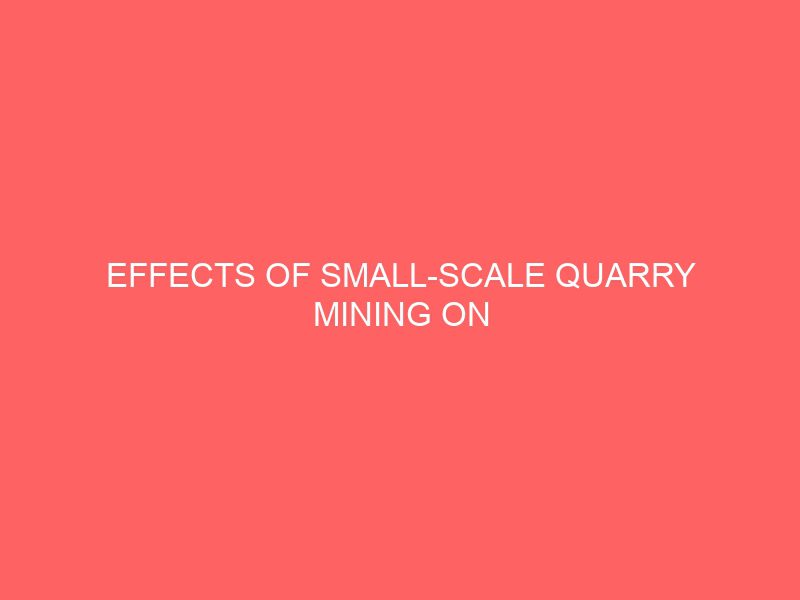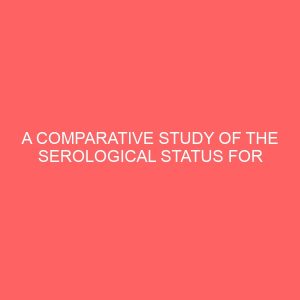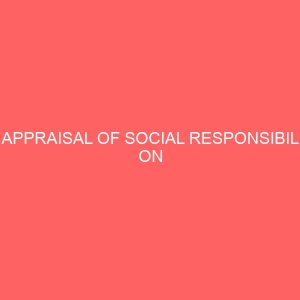Description
CHAPTER ONE INTRODUCTION 1.1 Background to the Study Work is an area of life which has general health implications (Bartley 2005 ; Martikainen, Maki and Jantt 2008), but there are specific health problems attached to each job, and these health problems abound in both informal and formal job engagements. The focus of this study is on the rural unskilled poor females who work in informal, unorganized sector of small-scale quarry mining. Gardner and Herz (1992), observed that some men and women are involved in undesirable work and working conditions, particularly in factories and industrial establishments. In some developing countries, these men and women in informal setting have no defined hours of work as most of them work very long hours (Conton, 1999). Women who are poor and work in factories and other establishments are also exposed to harmful chemicals or radiation, with grave health risks for themselves and their unborn children (United Nations, 1997); but some of the serious problems that affect women?s well-being in work places have remained hidden (National Council on Welfare , 1990). International Labour Organization (1993) observed that small-scale quarry mining is expanding rapidly and often uncontrollably in many developing countries, employing large numbers of women and children in dangerous conditions and generating workplace fatality rate of up to 90 times higher than mines in industrialized countries (Hinton 2003; Hinton and Beinhoff 2003). While it is not certain how many deaths and accidents occur in small-scale mines due to under-reporting and clandestine nature of much of the work, the risks of fatal and disabling accidents are high, particularly in underground mines (National Occupational Health and Safety, 2002). Although literature on quarry mining shows that men and women are exposed to the harmful effects in the mines, health hazards and degeneration of the health conditions of women is one of the most serious impacts of quarry mining, especially in the privately owned mines that do not care about mining safety (Tomb 1974; International Labour Organization 1993; Ashforth, Kreiner and Fugate 2000; Kegan and Lahey 2009). Here, women?s health has to be understood from a larger perspective of direct and indirect impacts of the exposure of women to mine disasters and pollution as well as the reduction of their quality of life, because they are underpaid (Demerouti, Bakker and Schaufeli 2005; Allen and Kraft 1980; Atkinson 1984; Barclay 1987; Blaxall and Regan 1976). Despite people suffering from several forms of ill-health, physical and mental, due to constant exposure to toxic wastes as a result of quarry mining, there is a gap in the availability of scientific studies and data on the health problems created by mining activities in developing countries and more so on women working in mining industry (Venter 2002; Smit 2005; Ranchod 2001). This has enabled mining industries to neglect their social responsibilities towards the employed and community where they are located, as these women fail to receive from the companies, sustainable livelihoods, from small incomes generated by their work, which equally is often not covered by health and safety insurance as most of the companies are illegally operated (Ahmad 2002; Ashley 1999; Blaike, Terry and Ben 1994; Brock and Coulibaly 1999; Dwyer and Judith 1988). The apathy, lack of understanding, lack of political will and gross corruption of the government enhances the operations of these industries without interruption (Matozi, 2003). As health issues are considered technical and scientific, the complaints through demonstrations and evidence from polluted communities and poor relationship of workers, with mining operators, and their ill-health are brushed under the carpet by law implementing, monitoring and judicial authorities, especially in the developing countries (Yaro, 2002; Weightman, 2002; UNIFEM, 2003; Marzano, 2002), on the pretext of improper and inadequate scientific corroboration (Gill, 1987; Bose, 2004; World Bank, 2006). Pitted against these forces are the women in the quarry mining regions, whose health issues like; physical injuries, mining related diseases, death fatalities in the mines are marginally addressed in the developing countries, because of the quarry mines illegal operations and governments lack of political will in implementing rules and regulations guiding the quarry mine operators (Hogger 2004; Jayalakhsmi 2005; Heemskerk 2005). Ranchod (2001) observed that the greater negative impact of quarry mining has been experienced by women , especially in developing nations, as most of the quarry mining activities have taken place in the rural areas, and the changes as a result, in the social and physical health of these women, have been fatal. They are already marginalized, as they face poverty and hardship, as well as extreme poor environmental conditions that offer little alternative resources for subsistence (World Bank, 2004). International Labour Organization (2007) estimates that as many as 4 million of the world?s 13 million small-scale miners are women. It is estimated that millions of children and women work often in intolerable conditions, especially in the developing countries (ILO, 2003). In Guinea, boys of 14 to 16 years of age work in the quarry mines at very low pay, digging gravel in trenches, removing water with buckets and diverting streams and rivers using sandbags. Surveys undertaken by ILO (2003) in Madagascar, Burkina Faso, Niger, Peru, Philippines and Tanzania found hundreds of children with their mothers in small-scale mines and quarries, many working as much as 10 to 14 hours, or more per day alongside their impoverished family members, especially women. F







